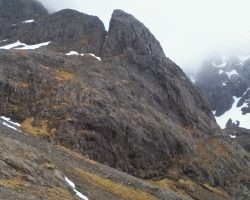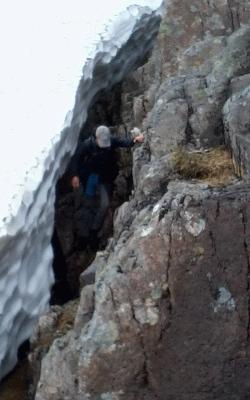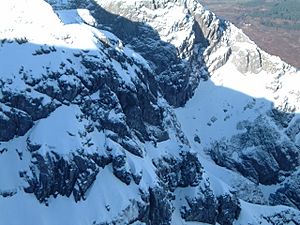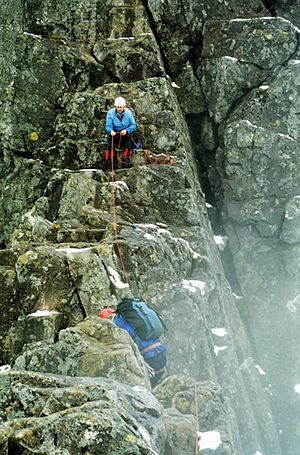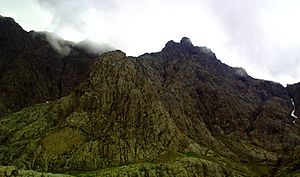Tower Ridge facts for kids
Tower Ridge is a famous path that sticks out from the top of Ben Nevis, the tallest mountain in the United Kingdom. It's one of several paths that lead up to the summit plateau from the northeast side of the mountain. People love climbing this ridge because it offers amazing views and a fun challenge!
Contents
Exploring Tower Ridge: A Climbing Adventure
Tower Ridge starts near a hut called Charles Inglis Clark, which is below a place called Coire Leis. From there, it goes all the way up close to the very top of Ben Nevis. It's a popular route for experienced hikers and climbers.
What Kind of Climb Is It?
Climbing Tower Ridge is a mix of scrambling and rock climbing. Scrambling means you use both your hands and feet to move up, but you don't always need ropes. Some parts of Tower Ridge are considered "difficult" rock climbing, meaning they are quite tricky.
In winter, when the mountain is covered in snow and ice, the climb becomes even harder. It's given a "Scottish Grade IV" in winter, which means it's a serious climb. This is because the hardest parts, like the Eastern Traverse and the Tower Gap, are high up on the ridge.
Key Features of the Ridge
As you climb Tower Ridge, you'll come across several distinct features. Here they are, in the order you would meet them going up:
- The Douglas Boulder: This is a big, cone-shaped rock about 200 meters tall. It's separated from the main ridge by two gullies (narrow valleys) on its east and west sides, which meet at a spot called the Douglas Gap.
- Most climbers avoid climbing directly up the Douglas Boulder. Instead, they usually scramble up the East Gully, which is an easier way to get to the main ridge.
- The Douglas Gap: This is where climbers who avoided the Douglas Boulder join the main path of Tower Ridge. From here, you climb a 20-meter "tricky chimney." This part became the hardest section of the route after some rocks fell in 2011. It can be slippery when wet!
- A Level Section: After the Douglas Gap, there's a short, almost flat part of the ridge. It then gets steeper, leading to a small wall. You can climb over this wall or go around it by following a clear ledge to the right. Both ways are easy to find because many climbers have left marks from their crampons (spikes on boots for ice).
- Another Easy Section: This part is also fairly flat with some small ups and downs. It can feel a bit exposed (meaning there are steep drops on either side) as it passes over a deep gully called the Great Chimney on the east side.
- The Little Tower: This is a small step up on the ridge, about 50 meters past the Great Chimney. It signals that the ridge is about to get much steeper.
- The Great Tower: This is a much bigger and more impressive steep section of the ridge. It's reached after a short flat part and some easy ledges. Most climbers don't go straight up the front of the Great Tower because it's very difficult.
- Instead, they take a path called the Eastern Traverse. This is a high ledge that goes to the left and through a small tunnel-like space. From there, you climb some tricky walls directly up the side of the tower to a small pile of stones at the top.
- Tower Gap: This is a small dip in the ridge just beyond the Great Tower. It used to be the hardest part of the climb. The gap is only about three meters deep, but the ridge gets very narrow here, about one meter wide, with steep drops on both sides.
- Getting down into the gap can be tricky, but climbing out is usually straightforward. You can also go around the Tower Gap entirely by extending the Eastern Traverse further down and around, rejoining the ridge later.
- Final Scramble to the Summit: After Tower Gap, it's an easy scramble to reach the flat summit area of Ben Nevis.
History of Tower Ridge Climbs
Tower Ridge was first explored by J., E., and B. Hopkins. They climbed down part of it on September 3, 1892, after having climbed up to the Great Tower the day before.
The very first time someone climbed all the way up Tower Ridge, and the first time it was climbed in winter, was on March 29, 1894. This amazing feat was achieved by Norman Collie, Godfrey Solly, and J. Collier. They went around the Great Tower on the right side, using a path called the Western Traverse. This path is actually harder than the Eastern Traverse, which is the route most people use today.


